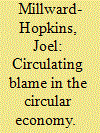| Srl | Item |
| 1 |
ID:
166521


|
|
|
|
|
| Summary/Abstract |
The transition from coal-based electricity to ‘carbon neutral’ biofuels derived from forests has catalysed a debate largely centred upon whether woody-biofuels drive deforestation. Consequently, a crucial point is often missed. Most wood pellets used in electricity production are derived from waste-wood; a practice considered acceptable by many otherwise strongly opposed to the industry. We highlight that, precisely because waste-wood is a ‘waste’, its carbon-neutral credentials should be questioned. We then examine a parallel development occurring within the same industrial system; the recovery of electricity producers’ combustion-ash residues for concrete production. Contrasting how accounting practices allocate upstream carbon to these ‘wastes’ in the cases of wood pellets and coal-ash reveals how decisions are shaped by industry imperatives, rather than established lifecycle techniques. If the politics of emissions allocation continue to evolve in this way, it may become increasingly difficult to distinguish where progress towards a low-carbon, environmentally sustainable and circular economy is real, from where it is an artefact of biased and inconsistent accounting practices.
|
|
|
|
|
|
|
|
|
|
|
|
|
|
|
|
| 2 |
ID:
185111


|
|
|
|
|
| Summary/Abstract |
The rapid expansion of urban development in Asia over the last 50 years has seen a rise in demand for building materials. From large construction companies to squatter settlers seeking to improve their housing, concrete is the building material of choice. In the Philippines there is plentiful supply of the limestone and aggregate (sand and gravel) required for concrete production. Alongside the large quarries owned by major corporations are small, often illegal quarries, supplying aggregate to the construction industry. In these shadow places informal miners scratch out a precarious livelihood. They are members of a vast artisanal and small-scale mining (ASM) workforce that is global in extent. This paper situates informal aggregate mining in the diverse economy of concrete in the Philippines and within the context of global ASM studies. With a detailed study of one quarry on the edges of Metro Manila, it reveals how mining contributes to the survival portfolio of poor households. Without romanticising the lives of quarry labourers, we identify a range of negotiations by which informal miners create a community of commoners in a contested quarry site. This research provides insight into the capacities that informal miners could bring to designing more sustainable development pathways within and beyond the extractive industry.
|
|
|
|
|
|
|
|
|
|
|
|
|
|
|
|